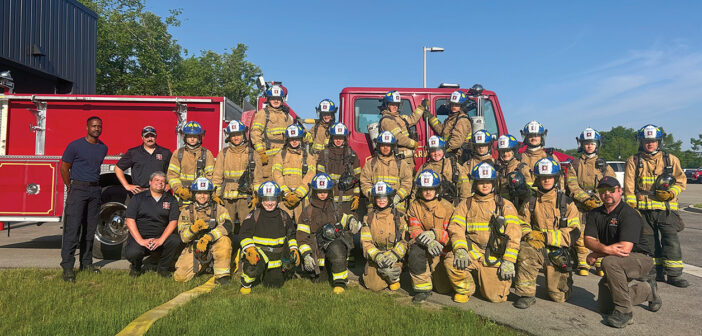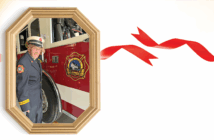In a time when the demand for firefighters is rising and departments across Michigan are struggling to fill positions, Genesee County has stepped up with an innovative solution—starting at the high school level. The Genesee Career Institute (GCI) Fire Academy, launched in 2021, is doing more than just preparing students for a career—it’s changing lives.
A Vision Ignited
The GCI Fire Academy was created through a partnership with the Genesee County Association of Fire Chiefs. What began as a humble setup in an on-site garage has since grown into a state-of-the-art training facility located on Torrey Road in Flint. It was one of the first programs of its kind in the area, and its success is paving the way for a new generation of firefighters.
The adult Genesee County Fire Chiefs Academy had long existed, but the need to cultivate younger talent led to this high school-focused program. Designed as a full-time, three-session course, the academy offers students hands-on training and the potential to graduate with full certification.
From Firefighter to Mentor
Jason Abbey, one of the academy’s instructors, has deep roots in Genesee County. A 2003 graduate of Linden High School, Abbey began his career in 2004 as a paid on-call firefighter with the Fenton Fire Department. Today, he lives in Fenton Township while he serves with the Hamtramck Fire Department as motor engineer and acting lieutenant, where he recently marked his 16th year.
His teaching journey began unexpectedly. While pursuing Fire Officer certifications, he earned his Fire Instructor 1 credential through the Detroit Fire Academy. “Initially, I had no intention of teaching,” Abbey said. “But doing my student hours opened my eyes—it became something I really enjoyed.”
Learning about the GCI academy and its urgent need for instructors, Abbey connected with local fire chiefs and soon joined the team. Teaching high school students, he admitted, was an entirely different challenge.
“Training teens to be firefighters—people who may not yet fully grasp the risks of the job—isn’t easy,” he said. “You’re trying to run a military-style academy while recognizing these are still kids. But the experience has changed me for the better.”
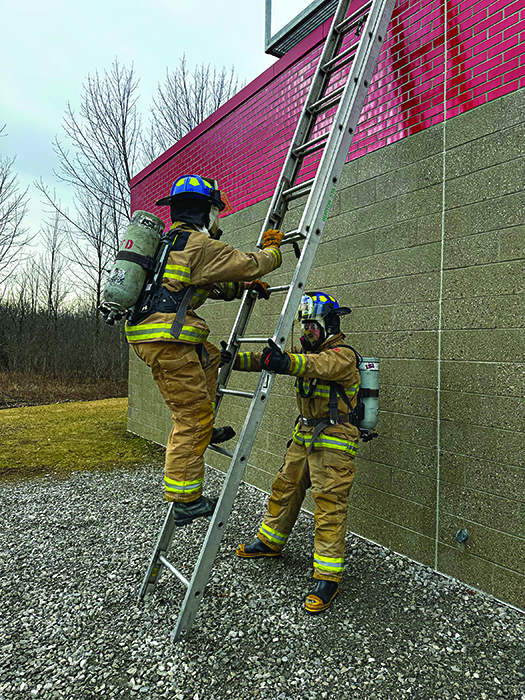
Students are demonstrating how to safely raise a ladder, climb to the top, step off, and lower it as part of the agility competition course.
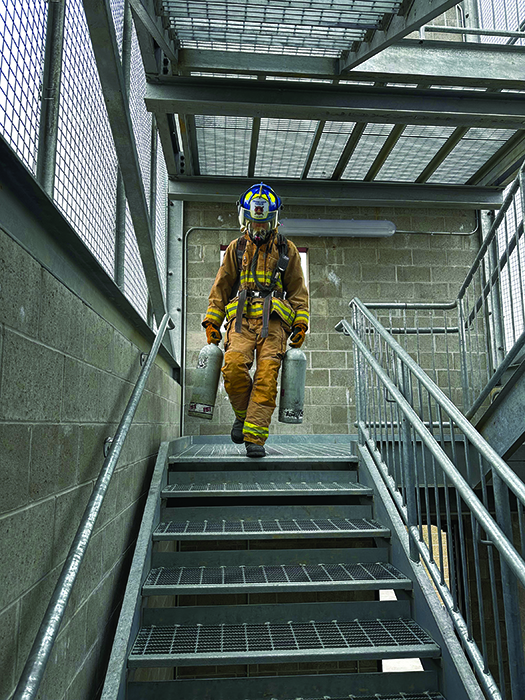
A Fire Academy student is using the training tower to simulate moving equipment between floors in a high-rise or apartment building.

Students are competing in a timed drill to transition from station wear to full PPE and SCBA—a critical skill that, once mastered, can be completed in under a minute.
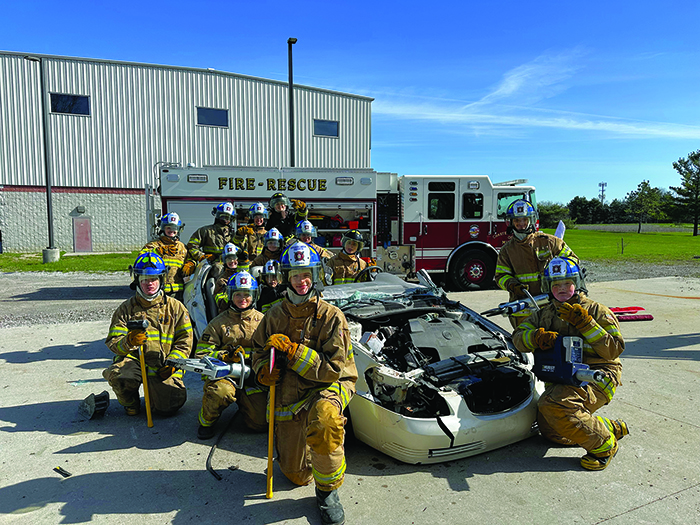
A group of Fire Academy students is posing with the vehicle they spent the past two days using to learn patient extrication techniques. They had to remove doors and the roof of the vehicle with the jaws of life and cutter tools.
Lighting the Path for the Next Generation
The fire academy offers a one-year program for high school students. It includes weekday instruction during school hours, along with some mandatory weekend training to meet the Michigan Bureau of Fire Services’ 240-hour requirement. Students may take the course for elective credit, or, if they complete the full training, they can sit for state certification exams in early June.
Those who pass, earn certification in Firefighter I & II, Hazmat Awareness and Operations, and CPR. From there, they can immediately apply for paid on-call positions or continue their training in EMT school.
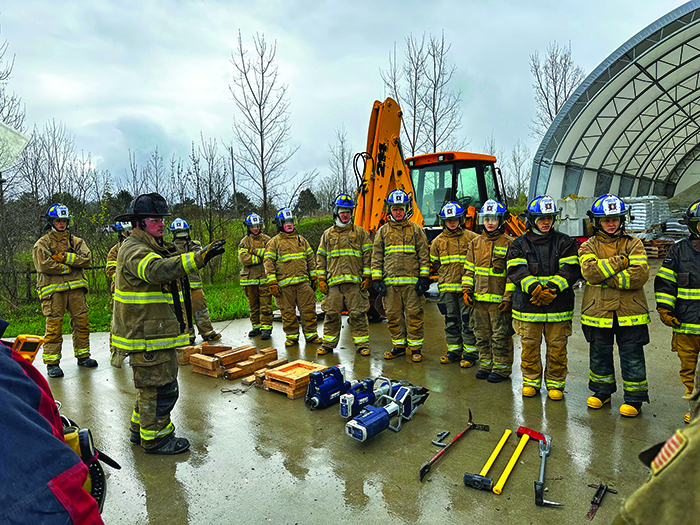
Students are being introduced to the extrication equipment they’ll use during the upcoming hands-on training.
In just two years, the academy has placed over 25 graduates into roles across part-time, full-time, and dual-trained public safety departments.
“The hiring crisis in Michigan’s fire service is still very real,” Abbey explained. “Departments are severely understaffed, with some relying on just four or five firefighters and heavily leaning on mutual aid for even basic calls. Full-time positions are more available than ever, and departments are offering sign-on bonuses and paying for training—things that were unheard of when I started.”
More Than Just Firefighting
The academy experience goes beyond basic training. Students learn ladder operations, power tool handling, forcible entry, hose deployment, search and rescue, ropes and knots, incident command, hazardous materials response, fire suppression systems, and vehicle extrication. They gain an understanding of building construction and get hands-on experience with SCBAs and live simulations.
But perhaps the most important lessons are the intangible ones: teamwork, courage, resilience, and selflessness.
“We’ve had students afraid to climb ladders or wear air packs,” Abbey shared. “Through mentorship and support, they overcame those fears and became successful graduates. It’s about breaking past limitations—physical and mental.”
Building a Firefighting Community
The fire academy creates a strong sense of camaraderie. Students form bonds through shared challenges, long days, and tough drills. As Abbey put it, “Firefighters never go alone. You learn early on that being part of a team is everything.”
While the program is based in Genesee County, enrollment is open to out-of-county students as well. Bus transportation is provided, and many students carpool.
As of August 5, the current instructional team includes:
▶ Lt. Kevin Harmes, formerly of Grand Blanc Fire Department, now the lead instructor
▶ Acting Lt. Jason Abbey, Hamtramck Fire Department
▶ Lt. James Wright, City of Flint Fire Department
▶ Jeremy Yonan, Fire Equipment Operator, City of Flint
▶ Lt. Juston Green, City of Flint Fire Department
They are supported by other local departments, including the Genesee County Hazmat Team and mutual aid partners for specialty certifications and equipment training.
“We’ve had students afraid to climb ladders or wear air packs. Through mentorship and support, they overcame those fears and became successful graduates. It’s about breaking past limitations—physical and mental.”
— Acting Lt. Jason Abbey
Expanding the Vision
With two fire engine bays, male and female locker rooms, a training tower, gear lockers, an equipment room, and an SCBA fill station, the academy is well-equipped—but still growing. Currently, it operates with one heavily used fire engine and is actively seeking donations of gear, tools, and vehicles.
“Our dream is to have a burn trailer and live fire training tower—just like Oakland and Schoolcraft colleges,” Abbey said.
“With the right support and funding, I truly believe that’s an achievable goal.”
Still Time to Enroll
Even though this story is being published in September, Abbey notes that students can still join the program if there are open slots. However, the further into the year they enroll, the more difficult it becomes to meet the 240-hour certification threshold.
A Brighter Future, One Firefighter at a Time
The GCI Fire Academy stands as a beacon of innovation, determination, and community spirit. It not only addresses the growing firefighter shortage but also instills values that will serve these young men and women throughout their lives—whether in the fire service or beyond.
“We’re not just training firefighters,” Abbey said. “We’re shaping future leaders.”

